Japan marked a momentous occasion on Saturday, becoming the fifth nation to land a spacecraft on the Moon. However, the success was tempered by concerns about the lander’s solar panels, which were not generating electricity, potentially cutting short the mission.
The Japan Aerospace Exploration Agency’s (JAXA) Smart Lander for Investigating Moon (SLIM) touched down on the lunar surface at around 12:20 a.m. (1520 GMT Friday). However, JAXA officials revealed that the lander’s solar panels were not functioning as expected, possibly due to misalignment.
With only battery power remaining, estimated to last “a few hours,” JAXA prioritized data transfer from SLIM back to Earth. They deactivated non-essential functions like the heater to conserve energy. JAXA hopes that a shift in the Sun’s angle over the next 30 lunar days might restore power to the panels.
“It takes 30 days for the solar angle to change on the moon,” explained Hitoshi Kuninaka, head of JAXA’s research center. “So when the solar direction changes, and the light shines from a different direction, the light could end up hitting the solar cell.”
Nicknamed the “Moon Sniper,” SLIM aimed for a landing within 100 meters of its target, a significant improvement over the usual accuracy of several kilometers. This technology, JAXA believes, holds immense potential for future exploration, particularly in the Moon’s hilly polar regions, considered a potential source of resources like oxygen, fuel, and water.
“Looking at the trace data, SLIM most certainly achieved a landing with 100-meter accuracy,” Kuninaka stated, though he added that definitive confirmation would take about a month.
Japan’s space program has witnessed both triumphs and setbacks in recent years. While partnering with the United States to counter China’s growing space influence and nurturing private-sector space startups, JAXA also faced the launch failure of its new flagship H3 rocket in March, hindering several missions, including SLIM and a joint lunar exploration with India.
The success of SLIM’s landing, despite the solar power issue, signifies Japan’s unwavering commitment to space exploration. They aspire to send an astronaut to the Moon as part of NASA’s Artemis program in the coming years.
In Sagamihara, near Tokyo, where JAXA’s control center is located, about 80 people gathered to witness the historic landing. The tense atmosphere during the descent gave way to cheers and applause when SLIM’s touchdown was confirmed.
(Inputs from Reuters)














